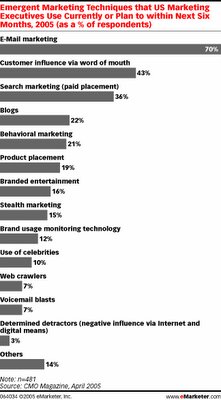
Word-of-Mouth Marketing Picks Up Speed
Published: November 03, 2005
There are dozens of metrics defining online advertising, but no one has locked down the defining numbers for word-of-mouth marketing. A new eMarketer report uncovers the "hidden statistics" of word of mouth.
Despite a long history, word of mouth as a marketing discipline is only just coming into its own, and the data indicate its best years are yet to come. eMarketer estimates that about half of all online marketers are engaging in some form of word of mouth or viral campaign, and that number will grow.
"While online advertising and all of its many subcategories such as search have dozens of metrics defining their size, shape and growth rates, no one has locked down defining numbers for word-of-mouth marketing," says Geoff Ramsey, eMarketer CEO and author of the Word of Mouth Marketing report. "It has been the 'hidden statistic.'"
Based on aggregated data from dozens of sources, as well as interviews with various word of mouth marketing experts, for the first time, eMarketer — in partnership with the Word of Mouth Marketing Association (WOMMA), uncovers the numbers behind the rumors, the facts behind the myths.
"Word of mouth has always been there, and it's always been the thing that gets us to buy," says Andy Sernovitz, CEO of WOMMA. "What's exciting is that marketers can finally do something to harness this power—and measure the results. Word of Mouth has moved from anecdotal to actionable."
Today, according to consulting giant McKinsey, approximately two-thirds of all economic activity in the US is influenced by shared opinions about a product, brand or service.
A wide variety of surveys indicate that Americans are far more likely to turn to family, friends and other personal "experts" than to use traditional media for ideas and information about products and services. In fact, RoperASW, part of GfK Group, finds that over 90% of Americans cite word of mouth as one of the best sources of ideas and information. Further, they rate "word of mouth twice as important as advertising or editorial content and put one-and-a-half times more value on it today than they did 25 years ago."
A recent UK survey conducted by Mediaedge:cia asked consumers which factors made them most comfortable when purchasing a product. More than three-quarters cited the recommendation of a friend.
Word of mouth is often referred to as "friends and family marketing," and with good reason. According to NOP (like Roper, a GfK unit), people are more likely to pass along messages via word of mouth to their friends and family members.
"The Internet has created a vast new social network of people," says Mr. Ramsey. "These online connections may be as profound as any offline relationship, such as members of health support groups, or they may be only fleeting, such as one consumer reading another's recommendation of a hotel on a travel site. But whether the connection is long or short, the person-to-person information exchanged online carries a weight that traditional corporate messaging simply can't match."
Advertising messages can be amplified by the new electronic social network. According to the Online Publishers Association (OPA), 10% of consumers who report seeing online video advertisements say they forward them on to a friend or family member — that means they were more often influencers than purchasers.
"The aggregation of the numbers gives us a powerful new lens through which we can more clearly see the entire story," says Mr. Sernovitz. "But now that word of mouth marketing is rapidly becoming part of the marketing mainstream, it faces the same big question being asked of all types of marketing: How do you measure it?"
Committed to answering that question, eMarketer and WOMMA have published the new Word of Mouth Marketing report. Take it from us, you should read it today.



